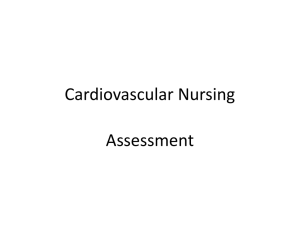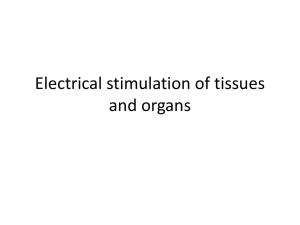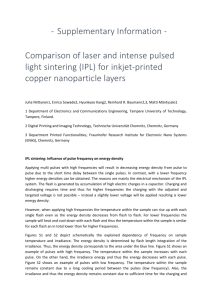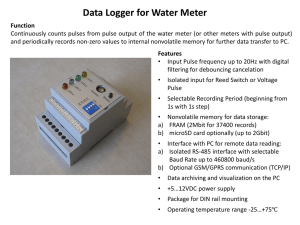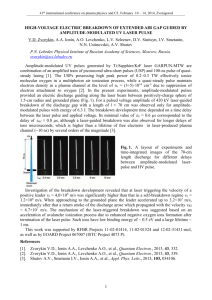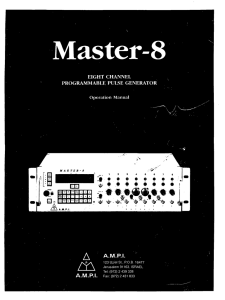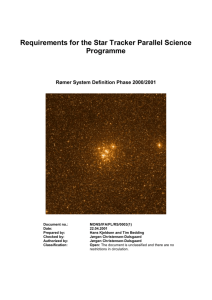Divide and Conquer is Always Best
advertisement
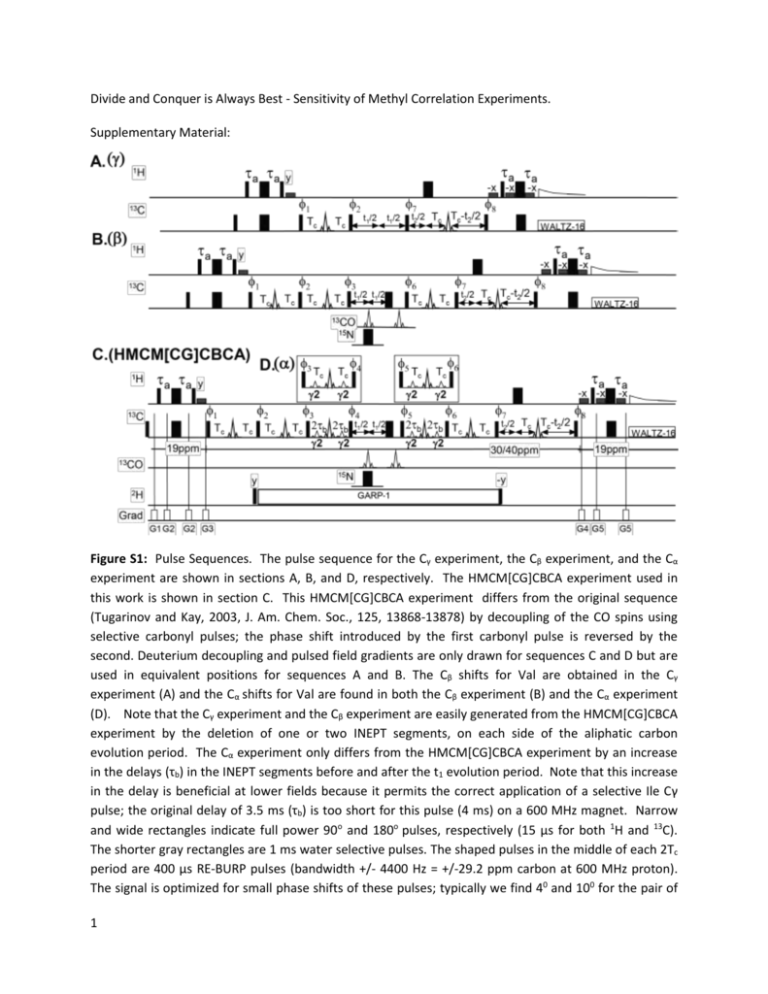
Divide and Conquer is Always Best - Sensitivity of Methyl Correlation Experiments. Supplementary Material: Figure S1: Pulse Sequences. The pulse sequence for the Cγ experiment, the Cβ experiment, and the Cα experiment are shown in sections A, B, and D, respectively. The HMCM[CG]CBCA experiment used in this work is shown in section C. This HMCM[CG]CBCA experiment differs from the original sequence (Tugarinov and Kay, 2003, J. Am. Chem. Soc., 125, 13868-13878) by decoupling of the CO spins using selective carbonyl pulses; the phase shift introduced by the first carbonyl pulse is reversed by the second. Deuterium decoupling and pulsed field gradients are only drawn for sequences C and D but are used in equivalent positions for sequences A and B. The Cβ shifts for Val are obtained in the Cγ experiment (A) and the Cα shifts for Val are found in both the Cβ experiment (B) and the Cα experiment (D). Note that the Cγ experiment and the Cβ experiment are easily generated from the HMCM[CG]CBCA experiment by the deletion of one or two INEPT segments, on each side of the aliphatic carbon evolution period. The Cα experiment only differs from the HMCM[CG]CBCA experiment by an increase in the delays (τb) in the INEPT segments before and after the t1 evolution period. Note that this increase in the delay is beneficial at lower fields because it permits the correct application of a selective Ile Cγ pulse; the original delay of 3.5 ms (τb) is too short for this pulse (4 ms) on a 600 MHz magnet. Narrow and wide rectangles indicate full power 90o and 180o pulses, respectively (15 μs for both 1H and 13C). The shorter gray rectangles are 1 ms water selective pulses. The shaped pulses in the middle of each 2Tc period are 400 μs RE-BURP pulses (bandwidth +/- 4400 Hz = +/-29.2 ppm carbon at 600 MHz proton). The signal is optimized for small phase shifts of these pulses; typically we find 40 and 100 for the pair of 1 pulses after the t1 labeling period. The shaped pulses labeled γ2 are frequency shifted 4ms RE-BURP pulses, applied at 16 ppm (bandwidth +/- 440 Hz = +/-2.92 ppm carbon at 600 MHz proton). The shaped carbonyl inversion pulses are frequency shifted 400 μs RE-BURP pulses, applied at 176 ppm and are only required for the Cβ (if Val is being detected) and the Cα experiments. The phases of all pulses are along x, unless otherwise noted. The carbon carrier frequency is at 19 ppm at the beginning and end of the sequence and shifted to 30 ppm (Cγ experiment) or 40 ppm after the INEPT sequences. Carbons are decoupled during acquisition using WALTZ-16 with a field strength of 2.5 kHz. Delays are τa=1.7 ms (1/4 JCH), TC=7 ms (1/4 JCC). Phase cycle is φ1 = (x,-x), φ2 = φ3 = φ4 = (y, y, -y, -y), φ5 = φ6 = φ7 = (y4, -y4), φ8 = (x, x). This phase cycle gives acceptable spectra with four scans, which is useful in the higher sensitivity Cγ and Cβ experiments. Quadrature detection is by States-TPPI, varying φ1 through φ4 for t1 and φ8 for t2. 2H decoupling is accomplished using a 500 Hz field at 2ppm and is applied between the carbon pulses with phases φ2 and φ7 in all experiments. The 90y and 90-y 2H pulses were applied at the same power level. Gradients are sine-shaped and applied as follows: G1 (500 μs, 10%), G2 (1000 μs, 20%), G3 (1200 μs, 24%), G4 (1400 μs, 24%), G5 (500 μs, 10%). For 15N labeled samples, a 180o nitrogen pulse should be applied with the first carbonyl 180o pulse, to refocus the coupling between the amide nitrogen and the Cα carbon. Guidelines for setting the maximum acquisition time in t1 (aliphatic carbon) and t2 (methyl carbon) are provided in figure S2. 2 Figure S2. Guidelines for Setting Maximum Carbon Evolution Times. When measuring the aliphatic shifts during t1 the active one-bond carbon-carbon couplings reduce the sensitivity of the experiment by converting a portion of the magnetization to a non-observable form. For example, in the Cα experiment Jαβ will convert the detectable term, 2CxαCzβ, to Cyα, which is not returned to the methyl group for detection. In the case of the Cβ and Cγ experiment, the magnetization evolves under two carbon-carbon couplings (Cβ experiment, Jαβ & Jβγ; Cγ experiment, Jβγ & JγMethyl). In addition to reducing the size of the detected magnetization, these couplings can also cause line broadening if unresolved in the spectra. To assess these effects on the peak intensity, free induction decays were generated assuming a carbon T2 of 50 msec. The amplitude of the FID was modulated by cos(πJt1) (one coupling) or by cos2(πJt1) (two couplings). These FIDs were processed with varying total acquisition times using a cosine squared apodization function. The sensitivity and linewidths are plotted as a function of the total acquisition time from both one C-C coupling (1J, solid line) or two C-C couplings (2J, dashed lined). The linewidths are given in ppm, assuming a magnetic field strength of 600 MHz 1H. Acquisition times of less than ~5 msec give unacceptably broad resonance lines due to truncation of the FID. Acquisition times in the range of 5-10 msec provide reasonable linewidths (2 to 1 ppm) with a ~10% drop in sensitivity from 92% at 5 msec to 82% at 10 msec. Additional narrowing can be achieved by extending the acquisition time to 15 msec with a further reduction in sensitivity to 75% for one C-C coupling or to 65% when there are two C-C couplings. Beyond 15 msec, the unresolved carbon-carbon couplings begin to cause extensive line broadening, greatly reducing the sensitivity. In the case of the evolution time for the methyl carbon (t2), only a single carbon-carbon couplings is active, thus acquisition times on the order of 15 msec can be used to increase the resolution of the methyl carbon dimension without extensive loss of the signal. 3 0.8 Relative Sensitivity 0.7 0.6 0.5 0.4 C C C 0.3 0.2 0.1 HMCM 0 100 90 80 70 60 50 40 30 20 10 T2 (msec) Figure S3: Relative Sensitivity of the Cγ, Cβ, Cα and HMCM[CG]CBCA Experiments as a Function of the Carbon T2. Sensitivities are relative to a 1H-13C HSQC spectra and assume that there is no relaxation loss during the proton-carbon transfer steps, that relaxation during the carbon-carbon coherence transfer periods is dominated by the T2 of the transverse carbon spin, and the excitation and refocusing pulses are ideal. 4 SW - HMCM[CG]CBCA SW - C SW - C SW - C C Val Ile Leu C C1 C C2 Cd Leu Ile Val Ile Leu Ile 70 65 60 55 50 45 40 35 30 25 20 15 10 13C Chemical Shift [ppm] Figure S4. Chemical Shift Ranges and Experimental Sweepwidths. The ranges of carbon chemical shifts typically found in proteins are shown on the lower part for Val (blue), Ile (red), and Leu (black). Note the close proximity of the Ile Cγ2 shifts to the Ile Cδ and Leu Cγ shifts, requiring a long selective pulse (γ2 pulse in figure 1) to selectively invert only the Ile Cγ2 spins. The upper part of the figure illustrates sweepwidths for the four experiments. The HMCM[CG]CBCA must cover the widest sweepwidth. In contrast, the Cα, Cβ, and Cγ all use narrower sweepwidths. In particular, the narrow sweepwidth used in the Cα and Cγ experiments permit the rapid recording of these spectra, signal intensity permitting. 5
